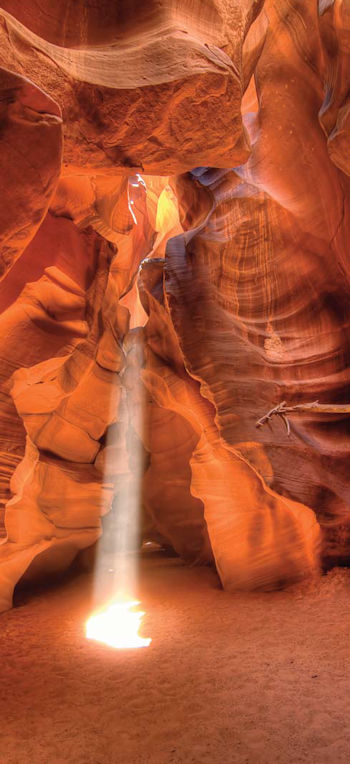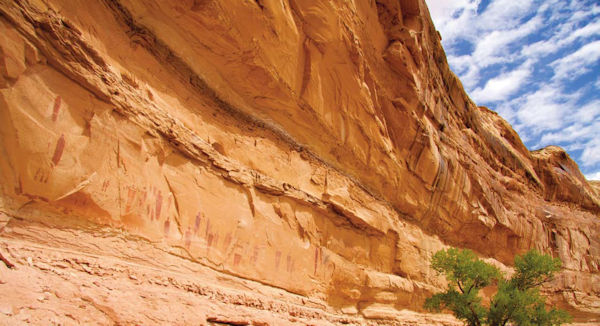SEJournal Online is the digital news magazine of the Society of Environmental Journalists. Learn more about SEJournal Online, including submission, subscription and advertising information.
Essay
By BOBBY MAGILL
 |
|
Perhaps the most famed slot canyon in the world, the short but spectacular Antelope Canyon on Navajo land near Page, Ariz., offers visitors other-worldly views, while simultaneously exposing them to potential disaster should they encounter a flash flood, the natural force that created these formations. Photo: Kevin Eddy via Flickr Creative Commons |
Among the joys of trekking into the wilderness is telling the story of a wondrous adventure to friends and family at the end of the trip.
In May, SEJ member and Arizona State University English professor Debra Schwartz wasn’t able to return home to tell the story of her canyon country explorations.After spending several days camping and hiking on her own, she fell to her death in an unnamed slot canyon, a narrow stone crevasse within Oak Creek Canyon near Sedona, Ariz.
I didn’t know Debra Schwartz, but I know well the wilds of the redrock canyon country she was exploring — the 130,000 square-mile Colorado Plateau centered on the Four Corners of Arizona, Colorado, New Mexico and Utah.
I and millions of others visit the Colorado Plateau each year not only to tell a story of our own explorations of this most-complex of American landscapes, but in part to decipher the stories of the ages coded in the sandstone, shale, petroglyphs and pictographs that imbue this land with a sense of naked history and geology found in few other places in the United States.
Hoodoos, goosenecks, goblins
Indeed, the canyon country Schwartz was exploring when she died is a primeval landscape replete with stories as rich as the redrocks are colorful.
There are the geologic stories of the ancient seas and dunes that built layer upon layer of the sandstone and shale through which every canyon slices, and the millennia of water and wind carving the rock into slots, hoodoos, natural bridges, arches, goosenecks, goblins and countless other geologic formations decorating the desert.
There are Paleo-Indian stories of hunting mastodons and mammoths painted on canyon walls in pictographs nearly 10,000 years old, and ancestral Puebloan stories told in petroglyphs and cliff dwellings perched high in distant canyons.
The names on topographic maps suggest more stories: Bedrock and Paradox. Desolation Canyon. The Scorpion. Nipple Butte. Cobra Arch. The Wave. Vermillion Cliffs. Land of Standing Rocks. The Dollhouse. Waterpocket Fold. The Dirty Devil River. Klondike Bluffs. The Fiery Furnace.
How water shapes canyon country
In this land of naked rock and postcard-perfect scenery, each of those names suggests a place that is mysterious and extraordinary. Or, “where something strange and more beautiful and more full of wonder than your deepest dreams waits for you — beyond that next turning of the canyon walls,” as Edward Abbey, one of the region’s most famous authors, wrote in his memoir “Desert Solitaire.”
For me, Mee Canyon in Western Colorado near the Utah border is such a place — one that tells a paradoxical story of how water shapes canyon country in surprising ways.
After scrambling down a roughly-marked trail through the geologic layer cake — first the Morrison, then the Wanakah, Entrada and Kayenta formations, and finally the giant, sheer curtain of bright red Wingate Sandstone — you arrive on the canyon floor where you’re presented with something that seems like it shouldn’texist.
Most canyons are as you’d expect: Millions of years of intermittent torrents of silty water flowing downhill scored and scoured the rock, creating a gorge at times straight and other times meandering, but mostly cutting through the layers of stone deeper and deeper as time passes. At each meander, there is often a “gooseneck,” a high promontory of harder rock around which the water flows.
In Mee Canyon, the torrents had different ideas. The creek’s meander and the accompanying gooseneck cut themselves hundreds of feet into the canyon wall, curve sharply and exit again, creating the largest known canyon alcove on the Colorado Plateau — a cavern so large a 747 jumbo jet could fit inside.
Expeditions, disappearances, environmental battles
There are few other places in which Abbey’s words ring more true to me. The search for more of the paradoxical geologic stories keeps me slinking about the canyons, slots, hoodoos and grabens of the Colorado Plateau whenever I can get there.
The deeply personal stories scattered across canyon country keep me coming back, too.
They are stories of loss, mystery and triumph, self discovery and mythical environmental battles. They are the stories of JohnWesley Powell whose harrowing expeditions down the Colorado River in the 1860s helped to open the West to development. They are the stories of young explorer Everett Ruess, who in 1934 at the age of 20, wandered into canyon country never to be seen again.
It is also the story of the battle between the Sierra Club’s David Brower and the U.S. Bureau of Reclamation, from which came the preservation of the Grand Canyon and the Yampa River in Dinosaur National Monument, but also the damming of Glen Canyon and the construction of Lake Powell.
Exploring canyon country involves my own personal stories: The story of my first experience guiding summer-camp kids into the depths of Utah’s Dark Canyon, hiking for days in the heat of June unsure where we’d find water. The story of descending into Horseshoe Canyon in Canyonlands National Park and sitting in silence beneath the 10,000-year-old pictographs, wondering how they’ve survived the millennia so vividly displayed on the sandstone walls.
And, it’s my story of joining my partner on a trek to an impossibly remote corner of Arizona to scatter his late father’s ashes above the rim of an unspeakably beautiful redrock gorge.
Though we know how her story ends, we’ll never know the tale of what it was exactly that drew Debra Schwartz into an anonymous slot canyon on her last trip into the wilderness. She was trekking alone the day she fell, but in spirit, she was among those of us whose love of canyon country and the wondrous stories it tells runs deeper than the grandest gorge in Arizona and more passionate than the raging Colorado River in spring.
Bobby Magill is senior science and energy writer at Climate Central in New York, and serves on the SEJ Board of Directors. A longtime environmental journalist, he’s a Charleston, S.C. native with roots in Colorado and New Mexico.
 |
| The Great Gallery in Horseshoe Canyon in Utah’s Canyonlands National Park — roughly 40 miles off the nearest paved highway — is the location of some of the oldest known pictographs in North America, more than 10,000 years old. Discovering such firsthand remnants of ancient civilizations literally painted on the canyon walls is one of the main reasons the author and others are drawn to canyon country. Photo: © Bobby Magill |
* From the Fall 2016 SEJournal.













 Advertisement
Advertisement 



